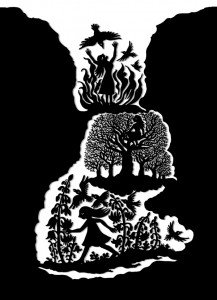Those saucy Grimms’ Fairy Tales that your mother never told you: the original first edition of 1812/15
by Professor Jack Zipes
24 Apr 2015
When Jacob and Wilhelm Grimm published their famous Kinder- und Hausmärchen (Children’s and Household Tales) in 1812, followed by a second companion volume in 1815, they had no idea that such stories as “Rapunzel,” “Hansel and Gretel,” and “Cinderella” would become the most celebrated in the world. Nor did they ever think that their collected tales would eventually be considered great children’s literature. Clearly, if they were living today, they would be shocked to discover how their tales have been misread and hyped and spread throughout the world in all sizes and shapes, not to mention in films and TV programs that might make them shudder.
Yet, despite their great fame, or perhaps because of their fame, few people today are actually familiar with the original tales of 1812/15. This is in part due to the fact that the Grimms published six other editions during their lifetime, each extensively revised and expanded in content and style, up until the final edition of 1857. From then on this so-called definitive edition has been translated into over 120 languages and often translated into English with illustrations geared to charm children. Interestingly, the Grimms, who were great philologists, never intended their original edition to be read by children, for it contains scholarly prefaces and notes and blunt and bizarre tales such as “How Children Played at Slaughtering,” “Riffraff,” fabulous animal stories, farces, and fragments about toads and spiders. Moreover, the Grimms did not shy away from erotic and scatological tales or from depicting gruesome family conflicts. So, Rapunzel is impregnated by a prince, and Snow White’s mother wants to murder the innocent girl not her stepmother. Lovers betray one another. Animals are more humane than humans. Many of the tales were recorded in dialect. Most of them did not have fairies, and almost all of them can be traced to European, Middle Eastern, and Asian sources.

Illustration: © Andrea Dezsö
In the autumn of 2014 I published the first complete English translation, The Original Folk and Fairy Tales of the Brothers Grimm,[1] in collaboration with Princeton University Press. All 156 stories from the 1812/1815 edition are now available in one beautiful book, accompanied by sumptuous illustrations by Andrea Dezsö. From strange tales such as “The Hand with the Knife,” “Herr Fix-It-Up” to “Princess Mouseskin” and “The Golden Key,” wondrous worlds unfold in this new collection – heroes and heroines are rewarded, weaker animals triumph over the strong, and simple bumpkins prove themselves not so simple after all. These unusual and startling tales resonate with diverse voices, rooted in oral traditions, that are absent from the Grimms’ later, more embellished editions of tales. While the tales in this first edition that I have translated cannot be considered the “authentic” Grimms’ tales because they originated in different regions of Europe, they are beguiling because they enable us to see how the Brothers worked as scholars and storytellers, using their knowledge and imagination to transform and create striking narratives that have influenced millions of readers.
[1] See The Original Folk and Fairy Tales of the Brothers Grimm: The Complete First Edition, Ed. and Trans. Jack Zipes. Princeton University Press, 2014.
Jack Zipes is Professor Emeritus of German at the University of Minnesota. In addition to his scholarly work on folk and fairy tales, he is an active storyteller in public schools. Some of his more recent publications include: The Enchanted Screen: The Unknown History of Fairy-Tale Films (2010), The Irresistible Fairy Tale (2012), and The Golden Age of Folk and Fairy Tales (2013). He has just publishedThe Original Folk and Fairy Tales of the Brothers Grimm: The Complete First Edition (2014).
Professor Zipes will be speaking at the following events, as part of the British Academy’s Literature Week 2015:
Worlds in Translation
Wednesday 13 May, 1-1.30pm
Sir John Ritbalt Treasures of the British Library Gallery, British Library, 96 Euston Road, London NW1 2DB
To celebrate European Literature Night 2015, this lunchtime talk with the British Library explores the art of translating fairy tales and folk tales. How do stories translate across languages and cultures, how do they change, what are the processes and considerations of the translator? On display will be a rare 1819 edition of the Grimms’ tales.
More: Literature Week Lunchtime Sessions.
and
The Golden Age of Retelling
Tuesday 12 May, 6-7.30pm
The British Academy, 10-11 Carlton House Terrace, London, SW1Y 5AH
In a fast paced, digital world, why do these stories survive? Why do they appeal to us as children and why do they follow us in to adulthood? Bringing together the literary with the social sciences, this event will explore why we just can’t stop telling tales.
More: The Golden Age of Retelling
Literature Week 2015
In May the British Academy explores the fantastical and the magical with a week on fairy tales and folk tales, literary genres which transcend cultural, historical and national boundaries.
Join authors, academics, writers, social commentators and cultural figures to explore some of the oldest genres in literature and to understand why, in a modern world, we are still so captivated by the chance to escape to ‘other worlds’.
The British Academy’s fourth biennial Literature Week will take place between 11-17 May.
More: Literature Week 2015.


